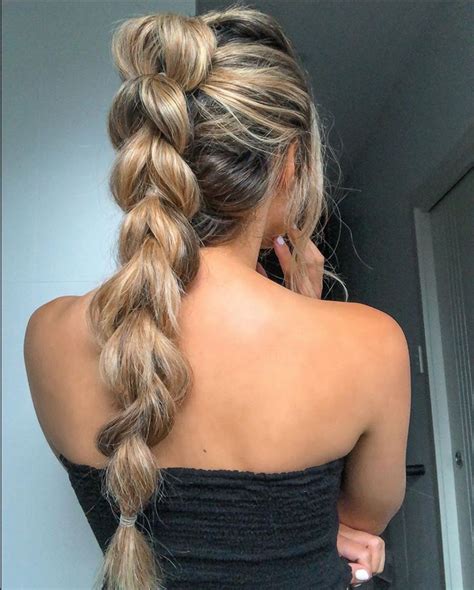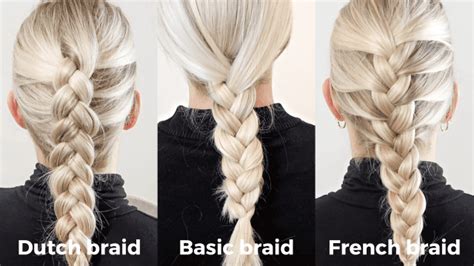Introduction

The world of hairstyling has been adorned with two timeless braiding techniques that have captivated generations: the Dutch braid and the French braid. Each boasting unique characteristics, these braids offer a versatile canvas for experimentation and creativity. In this in-depth comparison, we will delve into the intricate details of both techniques, exploring their differences, advantages, and practical applications.
Defining Characteristics
1. Placement of Strands:
- Dutch Braid: Strands are crossed under instead of over, resulting in a raised, three-dimensional effect.
- French Braid: Strands are crossed over each other, creating a flat and more subtle look.
2. Appearance:
- Dutch Braid: Exhibits a more voluminous and intricate appearance, resembling a raised crown.
- French Braid: Presents a smoother and more elegant finish, resembling a delicate lacework.
3. Difficulty Level:
- Dutch Braid: Requires a higher skill level and more practice to master.
- French Braid: Relatively easier to learn and execute, making it suitable for beginners.
Advantages and Disadvantages
Dutch Braid
Advantages:
- Versatile: Can be styled in countless variations, including buns, ponytails, or crowns.
- Volume and Texture: Adds instant volume and texture to thin or flat hair.
- Elaborate: Creates a striking and eye-catching look, perfect for special occasions.
Disadvantages:
- Time-Consuming: Can take a significant amount of time to braid, especially with longer hair.
- Tension: The underhand crossing creates tension on the scalp, which may be uncomfortable for some.
- Not Suitable for All Hair Types: May not be ideal for fine or slippery hair, as it can easily loosen.
French Braid
Advantages:
- Classic: A timeless and universally flattering braid that complements any face shape or hair texture.
- Versatile: Can be incorporated into various hairstyles, such as ponytails, buns, or headbands.
- Easy to Learn: Simpler technique that can be quickly mastered by beginners.
Disadvantages:
- Flatter Appearance: Produces a less voluminous and intricate look compared to the Dutch braid.
- Limited Styles: Offers fewer styling variations than the Dutch braid.
- Can Loosen Easily: The overhand crossing can make the braid prone to loosening, especially with heavy or thick hair.
Practical Applications
Daily Wear: French braids are more suitable for everyday wear due to their ease of styling and comfort.
Special Occasions: Dutch braids are ideal for formal events, weddings, or parties where a more elaborate and eye-catching look is desired.
Sports and Activities: Both braids offer secure and stylish options for active individuals, preventing hair from obstructing their vision or movement.
Hair Management: Braids can be used to tame unruly hair, prevent tangles, and protect hair from breakage.
Tips and Tricks
Creating a Perfect Dutch Braid:
- Section off the hair into three equal strands.
- Cross the right strand under the middle strand, then repeat with the left strand.
- Continue crossing the outer strands under the middle strand, tightly pulling each section as you braid.
- Secure the braid with an elastic band or bobby pins.
Creating a Perfect French Braid:
- Brush the hair to remove any tangles.
- Divide the hair into three equal strands.
- Cross the right strand over the middle strand, then repeat with the left strand.
- Continue crossing the outer strands over the middle strand, pulling each section snugly as you braid.
- Secure the braid with an elastic band or bobby pins.
Innovative Applications
The creative possibilities with Dutch and French braids are endless. Here are some unique applications to inspire you:
- Intricate Headbands: Braid a French or Dutch braid around your head as a stylish accessory.
- Messy Bun Braids: Incorporate Dutch or French braids into a messy bun for a textured and effortless look.
- Braided Crowns: Create a Dutch or French braid around the top of your head, leaving the ends free to hang down like a crown.
- Fishtail Braided Ponytails: Combine Dutch or French braiding techniques with a fishtail braid to create a unique and eye-catching ponytail.
Conclusion
Both Dutch braids and French braids are foundational hairstyling techniques that offer distinct advantages and applications. The Dutch braid’s intricate and voluminous appearance makes it perfect for special occasions, while the French braid’s classic elegance and ease of styling make it ideal for everyday wear. By understanding the differences between these two timeless braids, you can enhance your hairstyling repertoire and create a wide range of stunning looks for any occasion.
